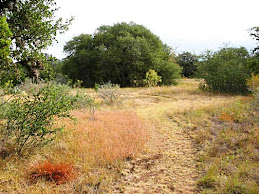
[
Except, of course, when it's the blossom of a Prickly Pear Cactus (Opuntia engelmanii). ]
] Another moist spring day, not what we usually expect but are grateful for nonetheless. I cannot get Avo's video to load, but I'll keep trying. Perseverance seems to be the secret to posting any video to the blog.
Since the Blow Dry episode, Avo the rooster has begun courting me with the wing and peck dance as he does Phoebe the blind sheep. I suppose in his mind my little act of kindness has given me passage into his harem.
Today I saw a flower blooming in my creek that I don't recognize. It's always nice to be a botanist and be stumped by something new, especially from your own place. Also, a neighbor introduced me to a yet-to-be-identified psychedelic-looking caterpillar that I photographed yesterday. I'll post those photos as soon as I know what they are.
 This year we have a hummingbird nest at eye-level in our creek, so it was easy getting close. The nest is about the size of a golf ball--smaller than what appears on your screen--made of lichen woven with spider webs. It has been fun to watch.
This year we have a hummingbird nest at eye-level in our creek, so it was easy getting close. The nest is about the size of a golf ball--smaller than what appears on your screen--made of lichen woven with spider webs. It has been fun to watch. These are Eastern Phoebe nestlings that fledged yesterday. This is the second year we've had them above our front door. Only one set is reared. I'm already having empty nest syndrome.
These are Eastern Phoebe nestlings that fledged yesterday. This is the second year we've had them above our front door. Only one set is reared. I'm already having empty nest syndrome. Here are the baby Barn Swallows living above our kitchen door. Mom takes them for practice flights around the well house. Soon they will be gone and she will begin another family, as she has for the past four years. Last year we had three sets. We also had a house wren nest between our screen and bedroom door, so it's been a a sweet spring.
Here are the baby Barn Swallows living above our kitchen door. Mom takes them for practice flights around the well house. Soon they will be gone and she will begin another family, as she has for the past four years. Last year we had three sets. We also had a house wren nest between our screen and bedroom door, so it's been a a sweet spring.
















.jpg)
+leaf.jpg)







+sm.jpg)

+sm.jpg)

.jpg)
+sm.jpg)





